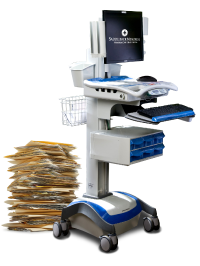
Saddleback Memorial Medical Center: The Future of Good Health

By Shelley T. Hudson
At Saddleback Memorial Hospital, your paper chart is history. Just last month, the hospital said goodbye to bulky, handwritten records and opened the door to innovation that minimizes errors and maximizes patient care. Its new electronic medical records program allows physicians, nurses and hospital staff to have immediate, secure access to each patient’s diagnosis, test results, imaging and history – all at the touch of a button.
The process that started at the Laguna Hills facility in 2006 has already streamlined access to patients’ records for doctors and other clinicians. A massive behind-the-scenes effort laid the groundwork for the transition from paper records to electronic ones. Hospital facilities were modified to accommodate additional computer equipment, air conditioning units and a sophisticated back-up system. Each patient’s paper record—”the chart,” as we more commonly know it—was digitized, including notes, x-rays, scans, test results, diagnoses and treatments. This overhaul puts Saddleback and all other MemorialCare hospitals at the forefront of medical technological advancements. Only 10% of hospitals in the country have made the change to paperless record keeping. In fact, MemorialCare was recently recognized in the Top 100 Integrated Healthcare Networks for 2011 for its timely and comprehensive transition.
With all MemorialCare facilities now up and running with the electronic medical records system, patients can travel freely between locations with the assurance that their medical information is accessible and in one place. Saddleback Memorial’s Hospital Administrator, Tony Struthers, says that implementing the system provides “a better framework for decision making,” and that “information in the hands of a decision maker in a timely manner will lead to better outcomes.”
Struthers explains that until the new system was put into place, a doctor’s typical day usually started with tracking down each patient’s chart before going on daily rounds. Within each paper record were handwritten notes from any number of clinicians and each section of the chart was updated separately. The doctor would have to scour through notes before visiting with a patient and then document the visit before moving on to the next patient. With the information easily accessible and contained, a doctor’s time can be more focused on care and treatment. Now that the data is available electronically, the physician can securely review a patient’s chart from anywhere—even an iPad or smartphone—and have the ability to make updates on the spot.
Since physicians can quickly consult with specialists through the electronic system, waiting hours, days or weeks for multiple doctors to confer is a thing of the past. Clinicians in separate locations can collaborate and develop patient treatment plans without delay. The electronic record virtually eliminates redundancy in testing, resulting in less hassle and expense for both patients and insurance providers. A built-in warning system also alerts clinicians to possible drug interactions, allergies, pre-existing conditions and other potential complications, providing an additional safety net for providers and patients.
The next phase of the transformation is integrating area physicians, Struthers explains. As it stands, when a patient comes to Saddleback Memorial’s Emergency Department, the treating physician can email the ER records to the patient’s family doctor for follow up. With wider integrations of private medical practices into the system, that step will also be eliminated. Saddleback Memorial’s satellite branches are a step ahead of this curve. The San Clemente Family Medicine office of Dr. Candace Basich and Dr. Amber Pashon and the practice of Dr. Lowell Kleinman, both in Talega, are already online with the MemorialCare electronic medical records system. Now that’s universal healthcare.
In addition to the “greening” of patient records, which significantly reduces paper consumption, Saddleback is working diligently to make additional environmentally responsible changes across the board. The hospital has eliminated landfill-dominating styrofoam products from the Dietary Department, which includes the hospital’s cafeteria and patient meal services. A new pilot project coordinated with local waste management services directs all food waste to a compost facility instead of a landfill. This effort not only considerably lowers the hospital’s cost of trash removal, it just makes good sense.
 The Local Dish Magazine Calendar of Events, Coupons and more for South Orange County!
The Local Dish Magazine Calendar of Events, Coupons and more for South Orange County!











